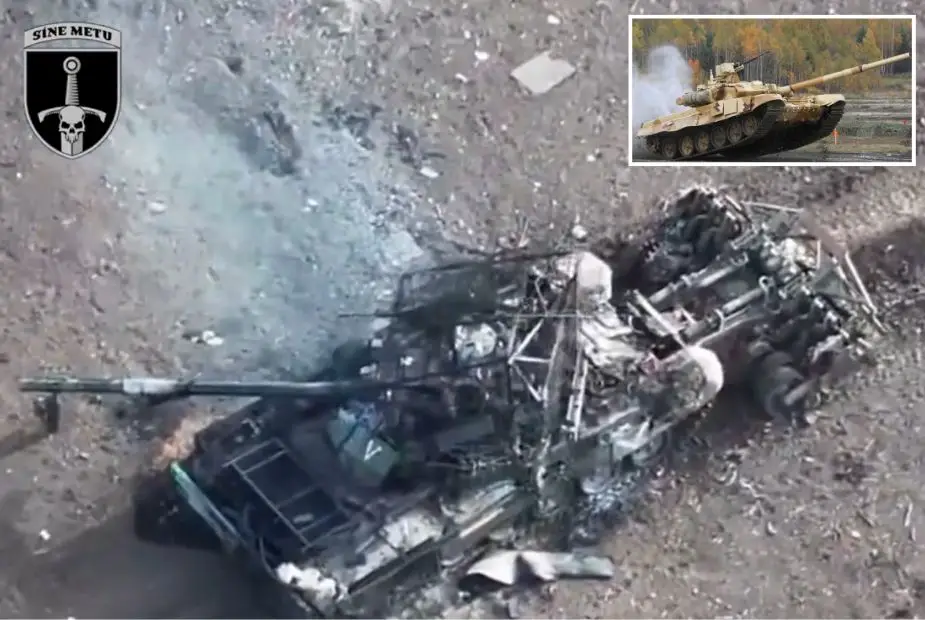A recent video published on the Telegram channel @Mechanized33/60 documents the destruction of a Russian T-90S tank in Donetsk. This incident marks the seventh recorded loss of the T-90S model, initially intended for export, since the onset of the conflict. Attributed to the actions of the Ukrainian 33rd Brigade, the destruction of this tank highlights the challenges faced by the Russian military in sustaining its operations in Ukraine. It reflects the use of not only older vehicles but also those originally intended for export.
Follow Army Recognition on Google News at this link

Since the conflict's inception, Russia is reported to have lost approximately 3,000 tanks, despite having reserves of older tanks to absorb these losses and having restarted production and modernization of numerous tanks (Picture source: Ukrainian 33rd Brigade/ Rosoboronexport )
This event underscores the intense military engagements ongoing in the Donetsk region. Located in the east of Ukraine, Donetsk is a region that plays a central role in the Ukrainian conflict. Rich in industrial and mining resources, notably coal, this area is strategic for both the Ukrainian economy and its geopolitical significance. Since 2014, Donetsk has become the epicenter of tensions between Ukrainian government forces and pro-Russian separatists, supported by Russia. The loss of the T-90S underscores the significant material costs incurred by both sides as they vie for territorial control.
Since the conflict's inception, Russia is reported to have lost approximately 3,000 tanks, despite having reserves of older tanks to absorb these losses and having restarted production and modernization of numerous tanks. Out of all the tanks deployed in Ukraine, only 200 were of recent manufacture, with the rest being refurbished units. Russia is now even using tanks initially designated for export, as evidenced by this recent destruction.
The T-90S Main Battle Tank (MBT), utilized by countries such as Algeria, Armenia, and India, is equipped with a primary 125 mm 2A46M smoothbore gun capable of firing up to 8 rounds per minute and launching 9M119 Refleks anti-tank guided missiles with a range of up to 4,400 meters.
It also features a 7.62 mm PKT coaxial machine gun and a 12.7 mm air defense gun mounted on the turret. The tank accommodates a three-person crew and includes compartments for the driver, a two-man turret, and the engine at the rear. Its defense mechanisms comprise steel armor and Kontakt-5 explosive reactive armor (ERA), bolstered by the Shtora-1 defensive aids suite, which includes an infrared jammer, laser warning system, and aerosol grenade system.
The T-90S is powered by a 1,000 hp V-92S2 V-12 diesel engine, capable of reaching speeds of up to 60 km/h on roads and 40 km/h off-road, with a maximum range of 550 km. It is equipped with various accessories, such as an NBC protection system, fire detection and suppression system, and a Thales Optronics thermal camera for enhanced night vision, ensuring functionality across diverse combat scenarios.
The T-90S is an export variant of the Russian T-90 main battle tank. While these two models share many features, such as armor and main armament, the T-90S exhibits significant differences tailored to the needs of foreign armed forces. For instance, the T-90S often incorporates enhancements in fire control systems and electronic protection, including more advanced navigation and communication systems to meet international standards. Additionally, it can be fitted with extra protection modules and specific weapon systems requested by the purchaser, making it more versatile in various combat scenarios compared to the standard T-90, which is optimized according to the specifications of the Russian army.
Defense News April 2024
















